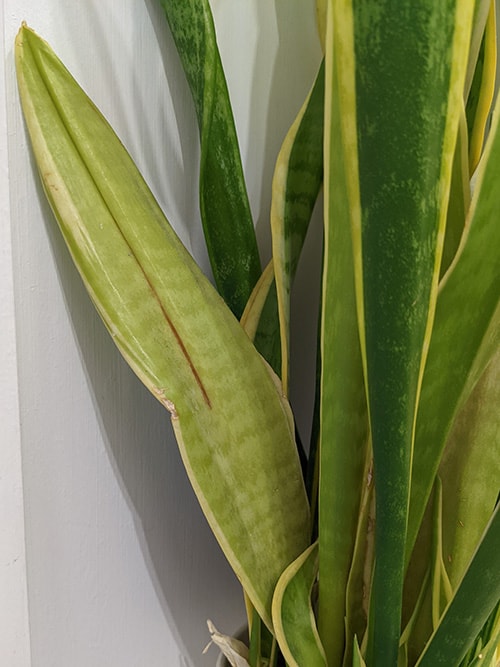Snake Plant Leaves Turning Yellow for Beginners
Table of ContentsThe Only Guide to Snake Plant Leaves Turning YellowThe Snake Plant Leaves Turning Yellow DiariesFascination About Snake Plant Leaves Turning YellowSnake Plant Leaves Turning Yellow - An OverviewSome Of Snake Plant Leaves Turning Yellow
The majority of signs and symptoms of origin rot aren't noticeable to the exterior of a plant, with the exception of one sign yellowing fallen leaves. When a snake plant has yellow fallen leaves, this is commonly an indication of overwatering causing root rot. When yellow, the fallen leave is basically dead because it's not getting any nutrients from the rotted roots.If the dirt is bone completely dry, it's time to sprinkle the plant. Snake plants in fact work best in clothes dryer problems than moist ones, so you ought to just sprinkle your snake plant when every 7-10 days.
Rather, the all-natural sunlight has to be indirect. This implies that if your serpent plant remains on a windowsill or surface area that is frequently in the sunlight, this is most likely the root cause of the yellowing fallen leaves. Yellow leaves imply that the plant is shedding from the sunlight, which then ultimately transforms brownish and crunchy.
While you may think that a window creates a barrier to prevent straight sunshine, the glass in fact creates a magnifying effect. The sunshine will then focus on certain components of the fallen leaves, leading to burnt leaves. Putting home window blinds can significantly decrease the sunlight strength! House plants require consistency to prosper.
Rumored Buzz on Snake Plant Leaves Turning Yellow
Any type of sudden modifications in these demands, especially the temperature, can result in the stress and anxiety of a plant. That's ideal stress and anxiety from radical adjustments in temperature results in yellow leaves. The primary reason to avoid placing your serpent plant with constant temperature adjustments is that it totally affects the dissipation process.
Obviously, in the onset, you may need to relocate the plant to discover its ideal environment once it's found a home, leave it there. Simply ensure the plant isn't near any heating or air conditioning aspects like ac system or radiators. Pest invasions such as mealybugs and crawler mites aren't too typical in serpent plants, however they can still be the source of yellowing leaves.

If you think you may have over-fertilized your snake plant, it's best to leave the plant alone for a couple of weeks to months.
Unknown Facts About Snake Plant Leaves Turning Yellow
When we stare at our beloved serpent plant and browse around these guys its delicious, glossy fallen leaves, we're seeing the magic of chlorophyll at work! When serpent plant leaves start to transform yellow, it's an indication they're lacking chlorophyll.
I've seen my share of challenges with the strong Snake Plant, consisting of the mystical yellowing of fallen leaves. Let's dive into the different causes behind this and just how to tackle them. Ironically, our great intents can often injure our Serpent Plant kingdoms. One common reason of yellow leaves is. Our first offender is something that may stun you.
: If the dirt is completely dry, repeat the procedure. Think it or otherwise, also our sturdy Snake Plants run out of their dietary supply after some time. When you first buy your Snake Plant, it features a decent quantity of nutrients in its potting mix. But with time, like any type of other houseplant, it exhausts this supply.
Here's a convenient guide for you: from the pot. Snake Plant Leaves Turning Yellow. For a more thorough guide on repotting, check out our write-up on Snake Plant kingdom are tropical citizens, and they like their temperature level stable and cozy.
Not known Facts About Snake Plant Leaves Turning Yellow
Icing up temperatures description can harm the leaves, and heats or heatwaves can quicken water loss and damage the healthy proteins holding chlorophyll. When these proteins are damaged, chlorophyll decreases, and the fallen leaves transform yellow. To treat this, ensure your Snake Plant is positioned in a location in your home with even more constant temperature levels.

Even the sun-loving serpent plant has its limits. To reduce this, relocate your serpent plant to a spot with.

The Ultimate Guide To Snake Plant Leaves Turning Yellow
Insects and fungal infections can suck the sap from the leaves, denying the serpent plant of nutrients and triggering the fallen leaves to transform yellow. The remedy? Relate to control the pests and fungal infections. Here's a quick guide to do it: neem oil from a gardening shop. the neem oil with water complying with Get More Information the suggested proportion on the bundle.
Snake plant leaves are susceptible to yellowing if the plant is not well cared for - Snake Plant Leaves Turning Yellow. Healthy and balanced serpent plants have a yellow coloring around the edges of their wide, upright leaf blades.